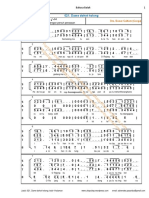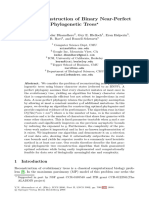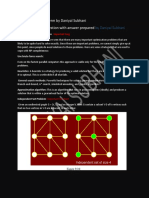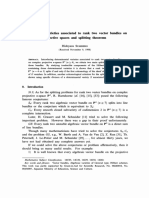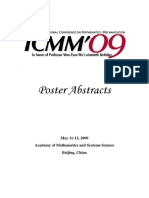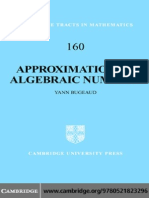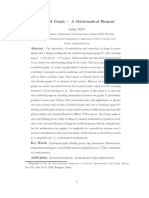05 Abstracts
05 Abstracts
Uploaded by
Mukta DebnathCopyright:
Available Formats
05 Abstracts
05 Abstracts
Uploaded by
Mukta DebnathOriginal Description:
Copyright
Available Formats
Share this document
Did you find this document useful?
Is this content inappropriate?
Copyright:
Available Formats
05 Abstracts
05 Abstracts
Uploaded by
Mukta DebnathCopyright:
Available Formats
The submitted abstracts are not refereed at this stage and
the authors are solely responsible for the claims made in their abstracts.
Invited Talks
Introducing Lexicographic Depth First Search
Derek Corneil
Department of Computer Science, University of Toronto
Toronto, Ontario M5S 3G4
derekg.corneil@gmail.com
Recently there has been a great deal of interest in multisweep algorithms based on Lexicographic Breadth
First Search (LBFS), introduced in a seminal paper by Rose, Tarjan and Lueker concerning the recognition
of Chordal graphs. Study of the four-vertex characterization of LBFS has led to the discovery of a new graph
search called Lexicographic Depth First Search (LDFS).
In this talk, we survey the many applications of LBFS and the characterizations of traditional searches that
lead to the discover of LDFS. We then show how LDFS helps solve the long standing question of finding a
minimum path cover of cocomparability graphs (graphs whose complement has a transitive orientation of its
edges) that does not resort to determining the bump number of the poset associated with the complement
graph. The talk concludes with open questions.
Some New and Old Results Regarding Room Squares and
Related Resigns
Jeff Dinitz
Department of Mathematics and Statistics, University of Vermont
Burlington, VT, 05405
jeff.dinitz@uvm.edu
In 1972 Wallis wrote the book on Room squares. Since that time there has been much work in the area of
Room squares and related designs, but some problems are still unsolved. In this talk I will discuss some of
these problems, in particular I will look at certain classes of Room squares, frames and 3-dimensional Howell
designs. The talk will end with a piece of music which is based on a large set of Room squares.
A Greedy Sorting Algorithm
Sergi Elizalde
Department of Mathematics, Dartmouth College
Hanover, NH 03755
sergi@gauss.dartmouth.edu
In sorting situations where the final destination of each item is known, it is natural to repeatedly choose items
and place them where they belong, allowing the intervening items to shift by one to make room. However,
it is not obvious that this algorithm necessarily terminates. We show that in fact the algorithm terminates
after at most 2n1 1 steps in the worst case, and that there are super-exponentially many permutations for
which this exact bound can be achieved. The proof involves a curious symmetrical binary representation.
Almost Resolvable Max Packings/Min Coverings Of K n With
4-Cycles
Curt Lindner
Mathematics Department, Auburn University
Auburn, AL, 36849
lindcc@auburn.edu
Let (X, C) be a max packing/min covering of Kn with 4-cycles. An almost parallel class of C is a largest
collection of vertex disjoint 4-cycles of C. So the deficiency of an almost parallel class consists of 0, 1, 2, or 3
vertices. (X, C) is said to be almost resolvable if C can be partitioned into almost parallel classes so that the
remaining 4-cycles are vertex disjoint. For example, (X, C) is an almost resolvable maximum packing of K11
with 4-cycles where: c1 = (4, 10, 8, 6)(5, 11, 9, 7); c2 = (4, 9, 6, 11)(8, 7, 10, 5), c3 = (1, 4, 5, 9)(2, 6, 3, 10), C
= c4 = (1, 6, 7, 11)(2, 4, 3, 8), c5 = (1, 5, 6, 10)(2, 7, 3, 11), c6 = (1, 7, 4, 8)(2, 5, 3, 9), and c7 = (8, 9, 10, 11),
where the leave is (1, 2, 3); and (X, P ) is an almost resolvable min covering of K11 with 4-cycles where P =
{c1, c2, c3, c4, c5, c6, c7} union (1, 5, 2, 6), (1, 7, 2, 3), where the padding is (1, 5, 6, 2, 7).
This is an elementary talk (maybe too elementary) outlining a complete solution of this problem (including
when n 1(mod 8) a 4-cycle system).
Maximal Sets in Graph Decompositions
Chris Rodger
Mathematics Department, Auburn University
Auburn, AL, 36849
rodgec1@auburn.edu
I am very thankful to Wal for being one of the pioneers of research into the existence of sets of factors that
are maximal in that none exist in the complement of the graph induced by the edges in the factors. The
complement is taken in the natural families of complete graphs and complete multipartite graphs. This talk
will include some historical perspectives on results in this area that involve Wals work, and some more
recent results, one being hot off the press.
Hats
Walter Wallis
Department of Mathematics, Southern Illinois University
Carbondale, IL, 62901
wdwallis@math.siu.edu
In a game show, a team of n players competes for a shared prize of $1,000,000. Each contestant enters the
studio blindfolded, and a hat is placed on his/her head. The hats are either black or red. The allocation of
hat colors is independent and random, with each player having 50% chance of red (a fair coin is tossed for
each player). When they are all hatted, the blindfolds are removed. A contestant cannot see his/her own
hat, but can see all the others. No communication is allowed. Each contestant has to guess the color of
his/her own hat (the contestant is also allowed to pass). They write down their answers either red or black
or pass independently and simultaneously, so that none has any idea of the other players responses. If
there is even one wrong answer, they lose. If they all pass, they lose. To win the money at least one player
must guess the correct color, and no one can get it wrong.
The players are told the rules, and that the allocation of hat colors is independent and random (50%). They
can then decide on a strategy. But remember, once the game starts there is no communication, and no
player knows any other players response before making his/her own.
What is the teams best strategy?
Acquisition Parameters for Graphs
Douglas B. West
Department of Mathematics, University of Illinois
Urbana, IL 61801
west@math.uiuc.edu
Given weights on the vertices of a graph (initially all weights equal 1), an acquisition move transfers weight
to a vertex v from a neighbor u such that the weight on u is at most the weight on v. The process ends when
the vertices with positive weight form an independent set. The aim is to minimize the size of that final set.
The full, partial, and fractional acquisition numbers are the minimum sizes of the final set when the amount
of weight transferred in a move is required to be all weight on u, any integer portion of that weight, or any
portion of the weight, respectively. We discuss bounds on these parameters in various families of graphs and
conditions for when they equal 1.
Finally, the game acquisition number is the result of optimal play in the variation where two players alternately make full acquisition moves, with one trying to minimize and the other trying to maximize the final
set. We discuss game acquisition for complete bipartite graphs.
Individuals involved in this research include T. LeSaulnier, K. Milans, N. Prince, P. Wenger, L. Wiglesworth,
and P. Worah.
Contributed Talks
On Representations of Graphs Mod n
Anurag Agarwal*, Manuel Lopez and Darren Narayan
School of Mathematical Sciences, Rochester Institute of Technology
Rochester, NY 14623
anurag.agarwal@rit.edu
Let G be a finite graph with vertices {v1 , v2 , . . . , vr }. A representation of G is an assignment of distinct
labels to the vertices such that the label ai assigned to vertex vi is in {0, 1, 2, . . . , n 1} and such that
gcd(ai aj , n) = 1 if and only if vi and vj are adjacent. We call {a1 , a2 , . . . , ar } a representation of G modulo
n. The representation number of a graph G, rep(G), is the smallest n such that G has a representation modulo
n. In this talk we will present the representation numbers of a family of complete graphs minus a disjoint
union of paths.
On the Oberwolfach Problem
Darryn Bryant* and Victor Scharaschkin
Department of Mathematics, University of Queensland
QLD 4072, Australia
db@maths.uq.edu.au
Let F be a 2-regular graph of order n, let Kn be the complete graph of order n, and for even n let Kn I
be the complete graph of order n with the edges of a perfect matching removed. When n is odd the
Oberwolfach problem OP(F ) asks for a 2-factorisation of Kn into copies of F , and when n is even it asks
for a 2-factorisation of Kn I into copies of F . In this talk I will outline a construction which settles the
Oberwolfach problem for infintely many odd and even values of n.
Characterizing the Intersection Graphs of Paths in Trees Using
PR-Trees
Steven Chaplick
Department of Computer Science, University of Toronto
Toronto, ON, M5S 1A1
chaplick@toronto.edu
A graph, G = (V={v1 , ..., vk }, E), is an intersection graph of paths in a tree (a.k.a. VPT graph a.k.a. UV
graph a.k.a. undirected path graph) iff there exists a collection of paths {P1 , ..., Pk } whose union forms a
tree, and there is an edge between vi and vj if and only if Pi and Pj have at least one vertex in common.
Additionally, by Gavril [?], a graph, G, is VPT iff there exists a tree, T, whose vertices correspond to the
maximal cliques of G, such that for every vertex, v, in G, the set of incident maximal cliques of G forms a
path (i.e. each path Pi consists of the maximal cliques incident with vi ). We refer to such a tree, T, as a
VPT representation of G.
In this talk we present a data structure (PR-trees) to represent the set of VPT representations of a graph G.
Furthermore, we demonstrate a polytime algorithm to construct a PR-tree from a given graph (note: when
there are no VPT representations an empty PR-tree is produced).
A Non-Existence Result and Large Sets for SB Designs
Hau Chan* and Dinesh Sarvate
Department of Mathematic, College of Charleston
Charleston, SC 29424
hchan@edisto.cofc.edu, SarvateD@cofc.edu
For n > 4, a strict (n 2)SB(n, n 1) does not exist. In this note, we prove a general result that for
3 t (n 3), a strict t-SB(n, n 1) does not exist. We modify the definition of Large sets of balanced
incomplete block designs appropriately for SB designs. An easy construction of such large sets for block size
two for all values of n is given as well as an example of a large set of an SB triple system for n = 4.
On the Edge-graceful Indices of the L-product of (p, p + 1)-Graphs
and K2
Kuo-Jye Chen*, Sin-Min Lee and Yung-Chin Wang
Department of Mathematics, National Changhua University of Education
Changhua, Taiwan
kjchen@cc.ncue.edu.tw
Let G be a (p, q)-graph and k > 0. A graph G is said to be k-edge graceful if the edges can be labeled by
k, k + 1, , k + q 1 so that the vertex sums are distinct, (mod p). We denote the set of all k such that G
is k-edge graceful by egI(G). The set is called the edge-graceful spectrum of G. In this paper the problem
of what sets of natural numbers are the edge-graceful spectra of three types of (p, p + 1)-graphs, namely the
L-product cycles with one chord, dumbbell graphs and one point union of cycles with K2 graph are studied.
On Some Combinatorial Arrays
D.V. Chopra*, Richard M. Low and R. Dios
Department of Mathematics and Statistics
Wichita State University
Wichita, KS 67260
dharam.chopra@wichita.edu
An array T with m rows (constraints), N columns (runs, treatment-combinations), and s levels is merely a
matrix T (m N ) with elements from a set S = {0, 1, 2, . . . , s 1}. These arrays assume great importance
in combinatorics and statistical design of experiments, when one imposes some combinatorial structure on
them. In this paper, we restrict ourselves to arrays with two elements 0 and 1. An array T is called an
orthogonal array (O-array) of strength t (0 t m) if in each (t N ) submatrix T of T , every (t 1)
vector with i (0 i t) ones in it appears with the same frequency (say). Here, is called the index
set of the O-array. Clearly, N = 2t . These arrays have been extensively used in design of experiments, in
coding and information theory, etc. Balanced arrays (B-arrays) are generalizations of O-arrays in the sense
that the combinatorial structure imposed on O-arrays is somewhat weakened, where every vector of weight
i (0 i t) appears with the same frequency i (say). Clearly if i = for each i, one gets an O-array. In
this paper, we will present some results on the existence of some of these combinatorial arrays.
On the Product-Cordial Index Sets of Cm Pn
Chao-Chih Chou*, Sim-Min Lee and Yung-Chin Wang
Holistic Education Center, St. Johns University
Tamsui, Taipei Shien, Taiwan
chao@mail.sju.edu.tw
L N
Let G be a graph with vertex set V(G) and edge set E(G), and let < Z2 , ,
> be the field of two
elements where Z2N={0, 1}. A labeling f : V(G) Z2 induces an edge labeling f : E(G) Z2 defined
by f (xy) = f (x) f (y), for each edge xy E(G). For i Z2 , let vf (i) = card{v V (G) : f(v) = i} and
ef (i) = card{e E(G) : f (e) = i}. A labeling f of a graph G is said to be friendly if | vf (0) vf (1) | 1.
If | ef (0) ef (1) | 1 then G is said to be product cordial. The product-cordial index set of the graph G,
PI(G), is defined as {| ef (0)V ef (1) | : the vertex labeling f is friendly}.
L Similarly, a labeling g: V(G) Z2
induces an edge labeling g* : E(G) Z2 defined by g (xy) = g(x) g(y), for each edge xy E(G). For
i Z2 , let vg (i) = card{v V (G) : g(v) = i} and eg (i) = card{e E(G) : g*(e) = i}. A labeling g of a
graph G is said to be friendly if | vg (0) vg (1) | 1. If, | eg (0) eg (1) 1 then G is said to be cordial. The
friendly index set of the graph G, FI(G), is defined as {| eg (0)V eg (1) | : the vertex labeling g is friendly}.
In this paper we show that all cylinder graph C3 Pn are not product-cordial and multilayer W4 wheels are
product-cordial.
On Edge-balance Index Sets of Cubic Trees
Ping-Tsai Chung* and Sin-Min Lee
Department of Computer Science, Long Island University
Brooklyn, New York, USA
chungp@acm.org
Let G be a graph with vertex set V (G) and edge set E(G), and let Z2 = {0, 1}. A labeling f : E(G) Z2 of
a graph G is said to be edge-friendly if {|ef (0) ef (1)| 1}. An edge-friendly labeling f induces a partial
vertex labeling f + : V (G) Z2 defined by f + (x) = 0 if the number of edges labeled by 0 incident on x
is more than the number of edges labeled by 1 incident on x. Similarly, f + (x) = 1 if the number of edges
labeled by 1 incident on x is more than the number of edges labeled by 0 incident on x. f + (x) is not define
if the number of edges labeled by 1 incident on x is equal to the number of edges labeled by 0 incident on x.
For i Z2 , let vf (i) = card{v V (G) : f + (v) = i} and ef (i) = card{e E(G) : f (e) = i}. The edge-balance
index set of the graph G, EBI(G), is defined as {|vf (0) vf (1)| : the edge labeling f is edge-friendly.}. A
tree is called cubic if all internal vertices are of degree 3. In this paper, exact values of the edge-balance
index sets of cubic trees are obtained, all of them form arithmetic progressions.
On The Mod(2)-Edge-Magic Graphs
Dharam Chopra, Rose Dios* and Sin-Min Lee
Department of Mathematical Sciences, New Jersey Institute of Technology
Newark, NJ 07102, USA
dios@adm.njit.edu
Let G be a (p, q)-graph in which the edges are labeled by 1, 2, , q. The vertex sum for a vertex v is the
sum of the labels of the incident edges at v. If the vertex sums are constant, mod k, where k > 2, then G
is said to be Mod(k)-edge-magic. In this paper we investigate graphs which are Mod(k)-edge-magic. When
k = p, the Mod(k)-edge-magic graph is the edge-magic graph which was introduced by the third author,
Eric Seah and S.K. Tan in 1992. We characterize trees and unicyclic graphs which are Mod(2)-edge-magic.
In particular, no trees of odd orders are Mod(2)-EM.
On decomposing complete graphs into Hamilton cycles and
n-cycles
S. El-Zanati*, K. King, J. Mudrock and C. Witkowski
Department of Mathematics, Illinois State University
Normal, IL 61790-4520
saad@ilstu.edu
Let n 3 be an integer and let m 2n + 1 be odd. It is known that if m 1 (mod 2n), then there exists
a cyclic Cn -decomposition of Km . Let k be a positive integer and let m = 2nx + 2k 1. We show that if
n is even or if 1 k n when n is odd and (n, k) 6= (5, 3), then there exists a cyclic Cn -decomposition of
K2nx+2k1 H, where H is a (2k 2)-regular spanning graph that can be factored into Hamilton cycles.
Matrices and Their Kirchhoff Graphs
Joseph D. Fehribach
Department of Mathematical Sciences, Worcester Polytechnic Institute
Worcester, MA 01609
bach@Math.WPI.edu
Given a matrix with integer or rational elements, this talk will introduce the concept of a Kirchhoff or
fundamental graph for this matrix. A Kirchhoff graph represents the fundamental theorem of linear algebra
for the matrix. The construction of these graphs and some of their properties will be discussed. The final
portion of this talk describes the connection between these graphs and chemical reaction networks which
motivates their definition.
Total Coloring of Cactus Graphs
C. Friedmann*, A. Lozano, L. Markenzon and C. Waga
Universidade Estadual do Rio de Janeiro, Brazil
Universidade do Grande Rio, Brazil
cliciavp@terra.com.br
In this paper, we present new results about coloring graphs. We generalize the notion of proper vertex
coloring presenting the concept of range-coloring of order k. The usual vertex coloring of G is a rangecoloring of order 1; we prove the equivalence of the range-coloring of order (G) and the distant-2 coloring.
The relation between range-coloring of order k and total coloring is presented: we show that for any graph
G that has a range-coloring of order (G) with t colors, there is a total coloring of G that uses (t + 1) colors.
This result provides a framework to prove that some families of graphs satisfy the Vizing conjecture for total
coloring. We exemplify with the family of cactus graphs.
Distance Magic Graphs and Tournament Scheduling
Dalibor Froncek*, Petr Kovar and Tereza Kovarova
Department of Mathematics and Statistics, University of Minnesota Duluth
Duluth, MN 55812
dalibor@d.umn.edu
A graph G with the vertex set V (G), edge set E(G) and |V (G)| = n is called distance magic if there exists
an injective mapping : V {1, 2, . . . , n} such that the weight of each vertex x, defined as
X
w(x) =
(y),
xyE(G)
is equal to the same constant 0 , called the magic constant. The labeling is called a distance magic labeling.
In some papers, is also called a 1-vertex-magic vertex labeling.
We present constructions of fair and handicap incomplete round robin tournaments based on distance magic
graphs.
If time permits, we may also present a construction of distance magic graphs arising from arbitrary regular
graphs based on an application of Kotzig arrays and present a solution of a problem posed by Shafiq, Ali
and Simanjuntak.
On the Edge Balance Index Sets of Flux Capacitor and
L-Product of Stars by Cycle Graphs
Meghan Galiardi*, Daniel Perry, and Hsin-hao Su
Department of Mathematics, Stonehill College
Easton, Massachusetts 02357
mgaliardi@students.stonehill.edu
Let G be a graph with vertex set V (G) and edge set E(G), and let Z2 = {0, 1}. A labeling f : E(G) Z2 of
a graph G is said to be edge-friendly if {|ef (0) ef (1)| 1}. An edge-friendly labeling f induces a partial
vertex labeling f + : V (G) Z2 defined by f + (x) = 0 if the number of edges labeled by 0 incident on x
is more than the number of edges labeled by 1 incident on x. Similarly, f + (x) = 1 if the number of edges
labeled by 1 incident on x is more than the number of edges labeled by 0 incident on x. f + (x) is not define
if the number of edges labeled by 1 incident on x is equal to the number of edges labeled by 0 incident on x.
For i Z2 , let vf (i) = card{v V (G) : f + (v) = i} and ef (i) = card{e E(G) : f (e) = i}. The edge-balance
index set of the graph G, EBI(G), is defined as {|vf (0) vf (1)| : the edge labeling f is edge-friendly.}. The
edge-balance index sets of Flux Capacitor graphs and L-Product with Stars by Cycles graphs are presented
in this paper.
Partial Covering Arrays and a Generalized Erd
os-Ko-Rado
Property
Particia A. Carey and Anant P. Godbole*
Department of Mathematics, East Tennessee State University
Johnson City, TN 37614-0663
GODBOLEA@mail.etsu.edu
The classical Erdos-Ko-Rado theorem states
if k bn/2c, then the largest family of pairwise intersecting
that
k-subsets of [n] = {0, 1, . . . , n} is of size n1
k1 . A family of k subsets satisfying this pairwise intersecting
property is called an EKR family. We generalize the EKR property and provide asymptotic lower bounds on
the size of the largest family A of k-subsets of [n] that satisfies the following property: For each A, B, C A,
each of the four sets A B C; A B C C ; A B C C; AC B C are non-empty. This generalized EKR
(GEKR) property is motivated, generalizations are suggested, and a comparison is made with fixed weight
3-covering arrays. Our techniques are probabilistic, and reminiscent of those used by Godbole et al (1996)
and in the doctoral work of Roux, as reported in the seminal paper of Sloan (1993).
Negative Cost Cycle Detection Problem in Undirected Graphs
Xiaofeng Gu
Department of Mathematics, West Virginia University
Morgantown, WV 26506-6310
xgu@math.wvu.edu
In this presentation, we explore the design of algorithms for the problem of checking whether a weighted
undirected graph contains a negative cost cycle (UNCCD). The mainly algorithm uses a T -join approach,
which runs in O(n3 ) time. We also show that if edge weights are restricted to be integers in [K, K], where
K is a constant, then the problem can be solve in O(n2.75 log n) time.
A Lexicographical Approach to SAT
Sergey Gubin
Genesys Telecommunication Laboratories Inc.
1255 Treat Blvd. Walnut Creek, CA 94596
sgubin@genesyslab.com
Lexicographical compatibility matrix is a Boolean box matrix which encodes a given CNF in the lexicographical contradictions between clauses. The given CNF is satisfiable iff there is a special pattern in the
matrix - a solution grid. The solution grids are in one-to-one relation with the implicants in DNF of the
given CNF. Disjunction of all solution grids is called a general solution of SAT. Search for solution grids
can be reduced to an asymmetric polynomial size linear system. This work researches another approach - a
dynamic programming procedure which is called depletion of the compatibility matrix. Formally, depletion
is just inversion in the compatibility matrix some of its true-elements. The depletion may be organized in
such a way that its result will be the general solution of SAT.
10
On Maximal k-Limited Packings
N. Ching, A. Finbow, R. Gallant, B. Hartnell* and R. Lingras
Department of Mathematical and Computing Sciece, Saint Marys University
923 Robie Street, Halifax, NS B3H 3C3, Canada
Hartnell@smu.ca
A k-limited packing P is a set of vertices in a graph with the property that the closed neighborhood of any
vertex in the graph contains at most k members of P . This could model, for instance, the desire to have a
limited number of obnoxious facilities in ones backyard. We consider the following two player game based
on this concept. The players alternate choosing a vertex in a graph. The only restriction is that at most k
vertices can be selected in the closed neighborhood of any vertex. Some preliminary observations from this
investigation will be outlined.
Sarvate-Beam Triple Systems for v = 5 and v = 6
Derek W. Hein* and P. C. Li
Department of Mathematics, Southern Utah University
Cedar City, Utah, USA 84720
hein@suu.edu
A Sarvate-Beam Triple System SB(v, 3) is a set V of v elements and a collection of 3subsets
of V such
that each distinct pair of elements in V occurs i times for every i in the list 1, 2, . . . , v2 . In this paper, we
completely enumerate all Sarvate-Beam Triple Systems for v = 5 and v = 6. (In the case v = 5, we extend
a previous result of R. Stanton.)
Weak Colourings of Cycle Systems
Daniel Horsley* and David Pike
Department of Mathematics and Statistics, Memorial University of Newfoundland
St. Johns, NL, Canada A1C 5S7
dhorsley@mun.ca
An m-cycle system of order v is a decomposition of the complete graph on v vertices into cycles of length m.
A weak colouring of an m-cycle system is a colouring of the vertices of the system such that no cycle has all
of its vertices receive the same colour, and the weak chromatic number of a system is the smallest number of
colours with which the system can be weakly coloured. This talk will deal with the problem of constructing
m-cycle systems with specified orders and weak chromatic numbers. Along the way we mention a new result
on embedding partial odd-cycle systems.
11
On Graphs Having Edge-magic Index Number Two
Yong-Song Ho, Wen-Chung Huang* and Sin-Min Lee
Department of Mathematics, So Chow University
Taipei, Republic of China
wchuang@math.scu.edu.tw
A (p, q)-graph G in which the edges are labeled 1, 2, 3, , q so that the vertex sums are constant, is called
supermagic. If the vertex sum (mod p) is a constant, then G is called edge-magic. A necessary condition
of edge-magicness is p divides q(q + 1). Lee, Seah and Tan showed that for any graph G there is an integer
k such that the k-fold graph G[k] is edge-magic. The least such integer k is called the edge-magic index of
G. We characterize some graphs whose edge-magic indices are two.
Cycle Designs With Loops
Spencer P. Hurd* and Dinesh Sarvate
Department of Mathematics and Computer Science, Citadel
Charleston, SC 29409
hurds@citadel.edu
We consider graph designs which decompose Kv (, j), the complete multi-graph on v points with multiple
edges for each pair of points and j loops at each vertex, into ordered blocks (a1 , a2 , ..., ak1 , a1 ) for k = 3, 4,
and have partial results for k = 5. Each block is the subgraph which contains the unordered edges {ai , aj },
for each pair of consecutive edges in the ordered list and contains also the loop at the vertex a1 . We have
complete results for k = 3, 4 and partial results for k = 5. Each block is the subgraph which contains the
unordered edges {ai , aj }, for each pair of consecutive edges in the ordered list and contains also the loop at
the vertex a1 .
Star Avoiding Ramsey Numbers
Jonelle Hook and Garth Isaak*
Department of Mathematics, Lehigh University
Bethlehem, PA 18015
gisaak@lehigh.edu
For graph Ramsey number R(G, H) = r what is the largest star such that we can leave its edges uncolored
in two coloring the complete graph on r vertices and still force a red G or blue H? For G and H complete
this is not interesting, all edges must be colored. We determine values for some special cases of G and H
(paths, cycles)where R(G, H) is known.
On the Irreducible No-Hole L(2, 1) Labeling of Graphs
Jobby Jacob* and Renu Laskar
School of Mathematical Sciences, Rochester Institute of Technology
Rochester, NY 14623-5604
jxjsma@rit.edu
Let G be a graph. A labeling f : V (G) {0, 1, . . . , k} of G is an L(2, 1) labeling if |f (u) f (v)| 2 when
u and v are adjacent in G, and |f (u) f (v)| 1 when u and v are at distance two in G. An L(2, 1) labeling
f is a no-hole L(2, 1) labeling if f is onto. An L(2, 1) labeling is irreducible if reduction of any label to a
smaller label violates the conditions of L(2, 1) labeling.
In this talk we will discuss some results regarding irreducible no-hole L(2, 1) labelings of different graphs.
12
Single Block Attacks and Statistical Tests on CubeHash
Benjamin Bloom and Alan Kaminsky*
Department of Computer Science, Rochester Institute of Technology
Rochester, NY 14623
ark@cs.rit.edu
This paper describes a second preimage attack on the CubeHash cryptographic one-way hash function. The
attack finds a second preimage in less time than brute force search for these CubeHash variants: CubeHash
r/b-224 for b > 100; CubeHashr/b-256 for b > 96; CubeHashr/b-384 for b > 80; and CubeHashr/b-512
for b > 64. However, the attack does not break the CubeHash variants recommended for SHA-3. The
attack requires minimal memory and can be performed in a massively parallel fashion. This paper also
describes several statistical randomness tests on CubeHash. The tests were unable to disprove the hypothesis
that CubeHash behaves as a random mapping. These results support CubeHashs viability as a secure
cryptographic hash function.
Vertex-Magic Edge Labeling Games on Graphs with Cycles
Adam Giambrone and Erika L.C. King*
Department of Mathematics and Computer Science, Hobart and William Smith Colleges
Geneva, NY 14456
eking@hws.edu
Given a graph G, let E be the number of edges in G. A vertex-magic edge labeling of G, defined by Wallis
in 2001, is a one-to-one mapping from the set of edges onto the set {1, 2, . . . , E} with the property that
at any vertex the sum of the labels of all the edges incident to that vertex is the same constant. In 2003,
Hartnell and Rall introduced a two player game based on these labelings, and proved some nice results about
winning strategies on graphs that contain vertices of degree one. In this talk we discuss results about winning
strategies for certain graphs with cycles where the minimum degree is two.
On Balance Index Sets of Generalized Wheel Graphs
Herbert A. Evans, Man C. Kong* and Sin-Min Lee
Department of Electrical Engineering and Computer Science, University of Kansas
Lawrence, KS 66045, USA
kong@eecs.ku.edu
Let G be a graph with vertex set V (G) and edge set E(G), and let A = {0, 1}. A labeling f : V (G) A
induces an edge partial labeling f : E(G) A defined by f (xy) = f (x), if and only if f (x) = f (y) for edge
xy E(G). For i A, let vf (i) = card{v V (G) : f (v) = i} and ef (i) = card{e E(G) : f (e) = i}. G is
said to be a balanced graph or G is balanced, if there is a vertex labeling f of G that satisfies the following
conditions:
(1) |vf (0) vf (1)| 1 and,
(2) |ef (0) ef (1)| 1.
The balance index set of the graph G, BI(G), is defined as {|ef (0)ef (1)| : the vertex labeling f is friendly}.
The Zykov sum of Cn and Nm is called the generalized wheel, and is denoted by GW(n, m). In this paper
we determine balance index sets of generalized wheels for m = 2, 3, 4, 5.
13
On Friendly Index Sets of (p, p + 1)-Graphs
Harris Kwong*, Sin-Min Lee and Yung-Chin Wang
Department of Mathematical Sciences, SUNY Fredonia
Fredonia, NY 14063
kwong@fredonia.edu
Let G be a graph with vertex set V (G) and edge set E(G). A vertex labeling f : V (G) Z2 induces an
edge labeling f : E(G) Z2 defined by f (xy) = f (x) + f (y) for each edge xy E(G). For each i Z2 ,
define vf (i) = |{v V (G) : f (v) = i}| and ef (i) = |{e E(G) : f (e) = i}|. The friendly index set of the
graph G, denoted FI(G), is defined as {|ef (0) ef (1)| : |vf (0) vf (1)| 1}. In this paper, we determine
the friendly index sets of some (p, p + 1)-graphs. Many of which form arithmetic progressions. Those that
are not miss only the second to the last term of the progressions.
Computing the Folkman Number Fv (2, 2, 2, 2, 2; 4)
Joel Lathrop* and Stanislaw Radziszowski
Department of Computer Science, Rochester Institute of Technology
Rochester, NY 14623
joel.lathrop@alum.rit.edu
For a graph G, the expression G (a1 , . . . , ar ) means that for any r-coloring of the vertices of G there exists
a monochromatic ai -clique in G for some color i {1, . . . , r}. The vertex Folkman numbers are defined as
v
Fv (a1 , . . . , ar ; q) = min{|V (G)| : G (a1 , . . . , ar ) and Kq * G}
Of these, the only Folkman number of the form F (2, . . . , 2; r 1) which has remained unknown up to this
| {z }
r
time is Fv (2, 2, 2, 2, 2; 4).
We show here that Fv (2, 2, 2, 2, 2; 4) = 16, which is equivalent to saying that the smallest 6-chromatic, K4 free graph has 16 vertices. We also show that the sole witnesses of the upper bound Fv (2, 2, 2, 2, 2; 4) 16
are the two Ramsey (4,4)-graphs on 16 vertices.
Partition Types
John J. Lattanzio
Department of Mathematic, Indiana University of Pennsylvania
Indiana, PA 15705
John.Lattanzio@iup.edu
For a graph G having chromatic number k, an equivalence relation is defined on the set X consisting of all
proper vertex k-colorings of G. This leads naturally to an equivalence relation on the set P consisting of all
partitions of V (G) into k independent subsets of color classes. The notion of a partition type arises and the
algebra of types is investigated. Visual assistance is provided by Mathematica.
14
On Balance Index Sets of Some Bi-regular and Tri-regular
Graphs
Andrew Chung-Yeung Lee*, Sin-Min Lee and Ho Kuen Ng
Department of Computer Science, University of Syracuse
Syracuse, New York, USA
andrewchungylee@gmail.com
Let G be a simple graph with vertex set V (G) and edge set E(G), and let A = {0, 1}. A labeling f : V (G) A
induces an edge partial labeling f : E(G) A defined by f (xy) = f (x) if and only if f (x) = f (y) for each
edge xy E(G). For i A, let vf (i) = card{v V (G) : f (v) = i} and ef (i) = card{e E(G) : f (e) = i}.
A labeling f of a graph G is said to be friendly if |vf (0) vf (1)| 1. If |ef (0) ef (1)| 1 then G
is said to be balanced. The balance index set of the graph G, BI(G), is defined as {|ef (0) ef (1)| :
the vertex labeling f is friendly.}. In this paper, the balance index set of a class of bi-regular graphs and a
class of tri-regular graphs are investigated.
On cordialness of k th power of graphs
Sin-Min Lee* and Maged Z. Youssef
Department of Computer Sciences, San Jose State University
San Jose, CA 95192, USA
lee.sinmin35@gmail.com
Let G be a graph with vertex set V (G) and edge set E(G). A labeling f : V (G) {0, 1} induces an edge
labeling f : E(G) {0, 1}, defined by f (xy) = |f (x) f (y)|, for each edge xy E(G). For i {0, 1}, let
ni (f ) = {v V (G) : f (v) = i} and mi (f ) = {e E(G) : f (e) = i}. A labeling f of a graph G is cordial if
|n0 (f ) n1 (f )| 1 and |m0 (f ) m1 (f )| 1. In this paper we show that under what conditions on G, the
k-th power Gk of G is cordial. Finally, we discuss the cordiality of Cnk .
New Bounds on Some Ramsey Numbers
Kevin Black, Daniel Leven*, and Stanislaw Radziszowski
Department of Mathematical Sciences, Rutgers University
New Brunswick, New Jersey 08901
danleven@eden.ruters.edu
We derive a new upper bound of 26 for the Ramsey number R(K5 P3 , K5 ), improving on the previous
upper bound of 28. This leaves 25 R(K5 P3 , K5 ) 26, improving on one of the three remaining open
cases in Hendrys tables, which listed Ramsey numbers for pairs of graphs (G, H) with G and H having five
vertices.
We also show, with the help of a computer, that R(B2 , B6 ) = 17 and R(B2 , B7 ) = 18 by full enumeration of
(B2 , B6 )-good graphs and (B2 , B7 )-good graphs, where Bn is the book graph with n triangular pages.
15
Hamiltonian Properties in Cartesian Product
Hongjian Lai, Hao Li* and Mei Lu
Department of Mathematics, West Virginia University
Morgantown, WV 26505
hli@math.wvu.edu
Ron Gould in [Problem 6, Graphs and Combinatorics, (2003)] raise a research problem to find natural
conditions to assure the product of two graphs to be hamiltonian. We prove that the following results:
(i) Let G be a hamiltonian graph and let T be a tree, then the Cartesian product G H is hamiltonian if
and only if the maximum degree of T satisfies (T ) |V (G)|.
(ii) Let G be a hamiltonian graph and let T be a tree, then the Cartesian product G H is traceable if and
only if either the maximum degree of T satisfies (T ) |V (G)| or (T ) = |V (G)| + 1 and any subdivisions
of K1,3 (V (G)) is not a subgraph of T . (Where K1,3 (n) is the graph identifying every degree one vertex of
K1,3 with the center of a K1,n .)
Contractible Graphs with Respect to Mod (2p + 1)-Orientations
Hong-Jian Lai and Yanting Liang*
Department of Mathematics, West Virginia University
Morgantown, WV 26506-6310
lyt814@math.wvu.edu
An orientation of an undirected graph G is a mod (2p + 1)-orientation if under this orientation, the net outdegree at every vertex is congruence to zero mod 2p + 1. A graph H is mod (2p + 1)-contractible if for any
graph G that contains H as a subgraph, the contraction G/H has a mod (2p + 1)-orientation if and only if G
has a mod (2p + 1)-orientation (thus every mod (2p + 1)-contractible graph has a mod (2p + 1)-orientation).
Jaeger in 1984 conjectured that every (4p)-edge-connected graph has a mod (2p + 1)-orientation. It has also
been conjectured that every (4p + 1)-edge-connected graph is mod (2p + 1)-contractible. In this paper, we
investigate graphs that are mod (2p + 1)-contractible, and as applications, we prove that a complete graph
Km is (2p + 1)-contractible if and only if m 4p + 1; that every (4p 1)-edge-connected K4 -minor free
graph is mod (2p + 1)-contractible, which is best possible in the sense that there are infinitely many (4p 2)edge-connected K4 -minor free graphs that are not mod (2p + 1)-contractible; and that every (4p)-connected
chordal graph is mod (2p + 1)-contractible.
On Almost-Edge-Graceful Trees
Sin-Min Lee and Sheng-Ping Bill Lo*
2217 Rivers Bend Cir,
Livermore, CA 94550, USA
bill lo1@hotmail.com
Let G be a (p, q)-graph in which the edges are labeled by 1, 2, , q. The vertex sum for a vertex v is the
sum of the labels of the incident edges at v. If the vertex sums are constant, mod p, then G is said to be
edge-magic. The edge-magic graphs were introduced by Lee, Eric Seah and S.K. Tan in 1992. If the vertex
set of G can be decomposed by V1 , V2 , , Vk where p 1 > k > 2, such that the vertex sums of vertices in
Vi are constant, mod p, then we say G is split(k)- edge-magic. In particular split (p 1)-edge magic graph
is called almost edge-graceful graph. In this paper we investigate trees which are almost-edge-graceful. We
conjecture that all trees of even orders are almost edge-graceful.
16
On (p, p + 1)-Graphs whose Edge-magic Indices are 3
Wen-Chung Huang, Sin-Min Lee and Shu-Wen Lo*
Department of Mathematics, Tamkang University
Taipei, Republic of China
shuwen4477@yahoo.com.tw
A (p, q)-graph G in which the edges are labeled 1, 2, 3, , q so that the vertex sums are constant, is called
supermagic. If the vertex sum (mod p) is a constant, then G is called edge-magic. A necessary condition
of edge-magicness is p divides q(q + 1). Lee, Seah and Tan showed that for any graph G there is an integer
k such that the k-fold graph G[k] is edge-magic. The least such integer k is called the edge-magic index of
G. We complete characterize (p, p + 1)-graphs whose edge-magic indices are three.
On Balance Index Sets of Corona of Regular Graphs and
Regular Graphs
Sin-Min Lee, Sheng-Ping Bill Lo, Richard Low*, R. Singh and Miao Yu
Department of Mathematics, San Jose State University
San Jose, CA 95192, USA
low@math.sjsu.edu
Let G be a simple graph with vertex set V (G) and edge set E(G), and let A = {0, 1}. A labeling f : V (G) A
induces an edge partial labeling f : E(G) A defined by f (xy) = f (x) if and only if f (x) = f (y) for each
edge xy E(G). For i A, let vf (i) = card{v V (G) : f (v) = i} and ef (i) = card{e E(G) : f (e) = i}.
A labeling f of a graph G is said to be friendly if |vf (0) vf (1)| 1. If |ef (0) ef (1)| 1 then G
is said to be balanced. The balance index set of the graph G, BI(G), is defined as {|ef (0) ef (1)| :
the vertex labeling f is friendly.}. The corona of two graphs G and H, written as G H, is the graph
obtained by taking one copy of G and |V (G)| copies of H, and then joining the ith vertex of G to every
vertex in the ith copy of H. For a connected graph a-regular graph G and any b-regular graph H we provide
complete information about the balance index set of G H.
An Improved Kernel Size for Rotation Distance in Binary Trees
Joan M. Lucas
Department of Computer Science, The College at Brockport
Brockport, NY 14420
jlucas@brockport.edu
Kernelization is one technique for studying intractable problems. By pre-processing a problem instance, and
converting it into an equivalent smaller instance, one can substantially lower the time needed to obtain a
solution. In this talk we consider the size of the kernel for the problem of computing the rotation distance
between a pair of binary trees, or, equivalently, computing the diagonal flip distance between a pair of convex
polygons. We show an improved bound of 2k on the size of the kernel.
17
On Balance Index Sets of Cylinder Graphs and Grid Graphs
Sin-Min Lee, Herbert Evans and Samantha Lui*
Department of Mathematics, San Jose State University
San Jose, CA 95192, USA
sluischool@yahoo.com
Let G be a simple graph with vertex set V (G) and edge set E(G), and let A = {0, 1}. A labeling f : V (G) A
induces an edge partial labeling f : E(G) A defined by f (xy) = f (x) if and only if f (x) = f (y) for each
edge xy E(G). For i A, let vf (i) = card{v V (G) : f (v) = i} and ef (i) = card{e E(G) : f (e) = i}.
A labeling f of a graph G is said to be friendly if |vf (0) vf (1)| 1. If |ef (0) ef (1)| 1 then G
is said to be balanced. The balance index set of the graph G, BI(G), is defined as {|ef (0) ef (1)| :
the vertex labeling f is friendly.}. In this paper, the balance index set of cylinder graphs are investigated.
In particular, we show that all the cylinder graphs and grid graphs are balanced.
On the Chromatic Number of H-Free Graphs of Large Minimum
Degree
Jeremy Lyle
Department of Mathematics, University of Southern Mississippi
Hattiesburg, MS 39406
samuel.lyle@usm.edu
The problem of determining the chromatic number of H-free graphs has been well studied, with particular
attention to Kr -free graphs with large minimum degree. Recent progress has been made for triangle-free
graphs on n vertices with minimum degree larger than n/3. In this talk, we will discuss the family of threecolorable graphs H, such that if H H, there exists a constant C < 1/2 such that the chromatic number of
any H-free graph G with (G) > (C + )n can be bounded above by a function of and H.
Pairs of Decompositions Into Lists of Cycles
Barbara Maenhaut* and Ben Smith
Department of Mathematics, The University of Queensland
Queensland, Australia, 4072
bmm@maths.uq.edu.au
Suppose M = m1 , m2 , . . . , ms and N = n1 , n2 , . . . , nt are arbitrary lists of positive integers. In this talk I will
present necessary and sufficient conditions on M and N for the existence of a simple graph whose edge-set
can be partitioned into s cycles of lengths m1 , m2 , . . . , ms and also into t cycles of lengths n1 , n2 , . . . , nt .
Some Families of Fixed Points for the Eccentric Digraph
Operator
Barbara M. Anthony, Richard T. Denman and Alison M. Marr*
Department of Mathematics and Computer Science, Southwestern University
Georgetown, TX 78626
marra@southwestern.edu
The eccentric digraph ED(G) of a digraph G has the same vertex set as G, and has a directed edge from
u to v if and only if the distance from u to v in G is e(u). A digraph is a fixed point under the ED operator
if ED(G)
= G. This talk looks at several examples of fixed points including a discussion of cycle products.
18
On (n, k, )-Ovals and (n, k, )-Cyclic Difference Sets, Multisets,
and Related Topics
John P. McSorley and Alan Schoen
Department of Mathematics, Southern Illinois University
Carbondale. IL 62901-4408
mcsorley60@hotmail.com
Each fixed integer n 2 has associated with it b n2 c rhombs, 1 , 2 , . . . , b n2 c . Rhomb h is a parallelogram
with smaller face angle equal to h n radians. An Oval is an equilateral centro-symmetric convex polygon,
each of whose turning angles equals ` n for some positive integer `. It is tiled by the rhombs 1 , 2 , . . . , b n2 c .
An Oval with 2k sides is called a (n, k)-Oval; it is described by its values of n and k and by its Turning
Angle Index Sequence (TAIS), a list of the turning angle indices for any consecutive set of k vertices. We
are interested in (n, k)-Ovals for which each rhomb is used times, we call these magic (n, k, )-Ovals. They
exist just when a (n, k, )-CDS, (cyclic difference set), exists. We also consider pseudo-CDS, multipliers of
CDS, and complements of Ovals.
Product Cordial Sets of Grids Pm Pn
Ebrahim Salehi, Yaroslav Mukhin*
Department of Mathematical Sciences, University of Nevada Las Vegas
Las Vegas, NV 89154
mukhiny@unlv.nevada.edu
Let G be a graph, and f : V (G) Z2 be a binary vertex coloring (labeling) of G. For i Z2 , let vf (i) =
|f 1 (i)|. The coloring f is said to be friendly if |vf (1) vf (0)| 1. That is, the number of vertices colored
0 is almost the same as the number of vertices colored 1.
Any friendly vertex coloring f : V (G) Z2 induces an edge labeling f : E(G) Z2 defined by f (xy) =
f (x)f (y) xy E(G). For i Z2 , let ef (i) = |f 1 (i)| be the number of edges of G that are labeled i. The
number pc(f ) = |ef (1) ef (0)| is called the product-cordial index (or pc-index) of f. The product-cordial set
(or pc-set) of the graph G, denoted by P C(G), is defined by
P C(G) = {pc(f ) : f is a friendly vertex coloring of G }.
In this talk we present the product-cordial sets of grids Pm Pn .
Intermediate Minimal k-rankings of Graphs
Darren A. Narayan
School of Mathematical Sciences, Rochester Institute of Technology
Rochester, NY 14623-5604
darren.narayan@rit.edu
Given a graph G, a function f : V (G) {1, 2, ..., k} is a k-ranking of G if f (u) = f (v) implies every u v
path contains a vertex w such that f (w) > f (u). A k-ranking is minimal if the reduction of any label greater
than 1 violates the described ranking property. The rank number of a graph, denoted r (G), is the minimum
k such that G has a minimal k-ranking. The arank number of a graph, denoted r (G), is the maximum k
such that G has a minimal k-ranking. It was asked by Laskar, Pillone, Eyabi, and Jacob if there is a family
of graphs where minimal k-rankings exist for all r (G) k r (G). We given an affirmative response to
their question showing that all intermediate minimal k-rankings exist for all paths, cycles, and Kn1 ,n2 , ..., Knp
where ni+1 = ni 1 for all 1 i p 1.
19
The Local Metric Dimension of a Graph
Futaba Okamoto
Mathematics Department, University of Wisconsin
La Crosse, WI 54601
okamoto.futa@uwlax.edu
For an ordered set W = {w1 , w2 , . . . , wk } of k distinct vertices in a nontrivial connected graph G, the metric
code of a vertex v of G with respect to W is the k-vector
code(v) = (d(v, w1 ), d(v, w2 ), , d(v, wk ))
where d(v, wi ) is the distance between v and wi for 1 i k. The set W is a local metric set of G if
code(u) 6= code(v) for every pair u, v of adjacent vertices of G. The minimum positive integer k for which G
has a local metric k-set is the local metric dimension of G. Results concerning these concepts are presented.
On the Edge-balance Index Sets of Centipede Graphs and
L-Product with Cycles by Stars Graphs
Meghan Galiardi, Daniel Perry*, and Hsin-hao Su
Department of Mathematics, Stonehill College
Easton, Massachusetts 02357
dperry1@students.stonehill.edu
Let G be a graph with vertex set V (G) and edge set E(G), and let Z2 = {0, 1}. A labeling f : E(G) Z2 of
a graph G is said to be edge-friendly if {|ef (0) ef (1)| 1}. An edge-friendly labeling f induces a partial
vertex labeling f + : V (G) Z2 defined by f + (x) = 0 if the number of edges labeled by 0 incident on x
is more than the number of edges labeled by 1 incident on x. Similarly, f + (x) = 1 if the number of edges
labeled by 1 incident on x is more than the number of edges labeled by 0 incident on x. f + (x) is not define
if the number of edges labeled by 1 incident on x is equal to the number of edges labeled by 0 incident on x.
For i Z2 , let vf (i) = card{v V (G) : f + (v) = i} and ef (i) = card{e E(G) : f (e) = i}. The edge-balance
index set of the graph G, EBI(G), is defined as {|vf (0) vf (1)| : the edge labeling f is edge-friendly.}. The
edge-balance index sets of Centipede graphs and L-Product with Cycles by Stars graphs are presented in
this paper.
The Sequence Maker-Breaker Game
Daniel Cranston, Bill Kinnersley, Kevin Milans, Gregory Puleo*
and Douglas B. West
Department of Mathematics, University of Illinois
Urbana, IL 61801
puleo@illinois.edu
The sequence maker-breaker game is played on a graded poset by two players, Maker and Breaker, who take
turns claiming elements of the poset for themselves. Makers goal is to claim a large chain in the poset,
claiming these elements in an order which agrees with the chain ordering. Breaker aims to prevent this.
More precisely, we will say that Breaker wins at level k if Breaker can prevent Maker from claiming any
chain which contains elements at levels {0, 1, . . . , k}; we will say that Maker wins if there is no k such that
Breaker wins at level k (i.e., if Maker can claim arbitrarily long chains). We show that this form of the
game is equivalent to a generalized version of Conways famous angel-devil game, and use these ideas to find
posets on which Maker wins and to prove results about biased versions of the game.
20
Multi-Deletion Reconstruction Numbers
of Small Graphs
David Rivshin* and Stanislaw Radziszowski
Department of Computer Science, Rochester Institute of Technology
Rochester, NY 14623
dfr2936@cs.rit.edu
In 1985 Harary and Plantholt described the concept of a Graph Reconstruction Number : the number of
1-vertex-deleted subgraphs of G required to uniquely identify G up to isomorphism. This concept can be
extended in the obvious way to both k-vertex-deleted subgraphs and k-edge-deleted subgraphs.
In a recent paper we reported the distribution of 1-vertex and 1-edge deleted reconstruction numbers for
all graphs on up to 11 vertices. Now we present the results of computation of many k-vertex and k-edge
reconstruction numbers of graphs up to 9 vertices.
On Deciding Whether the Distinguishing Chromatic
Number of a Graph is at most Two
E. M. Eschen, C. T. Ho`
ang, R. Sritharan*, and L. K. Stewart
Computer Science Department, The University of Dayton
Dayton, OH 45460
srithara@notes.udayton.edu
A vertex k-coloring of graph G is distinguishing if the only automorphism of G that preserves the coloring is
the identity automorphism. The distinguishing chromatic number of graph G, denoted D (G), is the smallest
positive integer k such that G admits a proper k-coloring that is distinguishing.
Cheng recently showed that when k 3, the problem of deciding whether the distinguishing chromatic
number of a graph is at most k is NP-hard. We consider the problem when k = 2. In regards to the issue
of solvability in polynomial time, we show that the problem is at least as hard as graph automorphism but
no harder than graph isomorphism.
Putting Dots in Triangles
Simon R. Blackburn, Maura B. Paterson and Douglas R. Stinson*
David R. Cheriton School of Computer Science, University of Waterloo
Waterloo ON, N2L 3G1, Canada
dstinson@uwaterloo.ca
Consider a triangle of n(n + 1)/2 unit squares in a grid. Denote by N (n) the maximum number of dots
that can be placed into the cells of the triangle such that each row, each column, andeach diagonal parallel
to the third side of the triangle contains at most one dot. We prove that N (n) = 2n+1
for all positive
3
integers n. Here is an (optimal) solution for n = 7:
s
s
s
s
s
It was proven
by Vaderlind, Guy and Larson (2002) and independently by Nivasch and Lev (2005) that
N (n) = 2n+1
. We give a new proof of this result using a linear programming approach.
3
21
On Balance Index Sets of Trees of Diameter Four
Sin-Min Lee, Hsin-hao Su* and Yung-Chin Wang
Department of Mathematics, Stonehill College
Easton, Massachusetts 02357, USA
hsu@stonehill.edu
Let G be a simple graph with vertex set V (G) and edge set E(G), and let Z2 = {0, 1}. A labeling f : V (G)
Z2 induces an edge partial labeling f : E(G) Z2 defined by f (uv) = f (u) if and only if f (u) = f (v) for
each edge uv E(G). For i Z2 , let vf (i) = |{v V (G) : f (v) = i}| and ef (i) = |{e E(G) : f (e) = i}|.
We call f is a friendly labeling if |vf (0) vf (1)| 1. The balance index set of G, denoted BI(G), is defined
as {|ef (0) ef (1)| : the vertex labeling f is friendly.}. In this paper, we study the balance index sets of
graphs which are trees of diameters four.
Generalized Leech trees
David Leach and Matthew Walsh*
Department of Mathematical Sciences, Indiana-Purdue University Fort Wayne
Department of Mathematics, Western Kentucky University
walshm@ipfw.edu
Let T be a tree on n vertices. Given an labeling w : E(T ) Z+ of the edges of T , define the weight of a
path on T as the sum of the labels onits
component edges. We say that w is a Leech labeling of T if the set
of path weights is precisely {1, 2, . . . , n2 }. A Leech tree is a tree together with such a labeling.
In this talk we introduce a generalization of this concept: instead of positive integers, take the labels from
some finite Abelian group (G, +). Our analogue of the Leech condition is that the set of path weights must
be precisely G {0}. We explore this for general groups, with particular emphasis on the case G = C2k .
Disjoint Cycles with Prescribed Lengths and Independent Edges
Hong Wang
Department of Mathematics, University of Idaho
Moscow, Idaho 83844
hwang@uidaho.edu
We conjecture that if k 2 is an integer and G is a graph order n with minimum degree at least (n + 2k)/2,
then for any k independent edges e1 , . . . , ek in G and for any integer partition n = n1 + + nk with
ni 4(1 i k), G has k disjoint cycles C1 , . . . , Ck of orders n1 , . . . , nk , respectively such that Ci passes
through ei for all 1 i k. We show that this conjecture is true for the case k = 2. The minimum degree
condition is sharp in general.
22
Constructions of (a, k)-Strongly Indexable Graphs from
(1, k)-Strongly Indexable Graphs
Sin-Min Lee and Yung-Chin Wang*
Department of Physical Therapy, Tzu-Hui Institute of Technology
Taiwan, Republic of China
jackwang@mail.tzuhui.edu.tw
For any integer a, k 1, a graph G with vertex set V (G) and edge set E(G), p = |V (G)| and q = |E(G)|,
is said to be (a, k)-strongly-indexable (in short (a, k)-SI) if there exists a function pair (f, f + ) which assigns
integer labels to the vertices and edges, i.e., f : V (G) {0, 1, . . . , p 1} and f + : E(G) {a, a + k, a +
2k, . . . , a + (q 1)k} are onto, where f + (u, v) = f (u) + f (v) for any (u, v) E(G).
We determine here classes of graphs that are (a, k)-SI graphs which are derivable from (1, k)-SI graphs.
Nonhomogeneous Nowhere Zero Flows in Line Graphs
Senmei Yao
Department of Mathematics, West Virginia University
Morgantown, WV 26506-6310
smyao@math.wvu.edu
Tutte in 1950s showed that a plane graph G has a face k-coloring if and only if G has a nowhere zero
A-flow, for any abelian group A with |A| > k. Jaeger et al extended the notion of nowhere zero flows to
nowhere zero (A, b)-flows, and then defined the A-connectedness. Let Z3 denote the cyclic group of order
3. And also Jaeger et al proposed a conjecture that every 5-edge-connected graph is Z3 -connected. I will
talk about that this conjecture holds for all 5-edge-connected graphs if and only if every 5-edge-connected
line graph is Z3 -connected. As supporting evidences to this conjecture of Jaeger et al, we prove that every
6-edge-connected triangulated line graph is Z3 -connected. Moreover, by using Ryjavceks line graph closure,
we also prove that every 7-edge-connected triangulated claw-free graph is Z3 -connected.
Steganosis Using Orthogonal Wavelets With Conditional
Probability and Primitive Polynomials
Evangelos A. Yfantis
Computer Vision Laboratory, School of Computer Science University of Nevada
Las Vegas, NV 89154-4010
yfantis@cs.unlv.edu
In this paper we introduce a theory to perform steganosis (transmit messages using images, video, and or
audio). We devise an orthogonal reversible wavelet transformation. Depending on the size of the message
we embed the message in an image video or audio without altering the original signal, using combinatorics
and conditional probability theory. We devise the key using an algorithm similar to the advanced encryption
standard, using primitive polynomials and matrix transformations. We present two methods one that the
key has already been transmitted and the other that the encrypted key is hidden in the image or video
along with the signal. To assure that the integrity of the transmitted signal is not lost we apply lossless
compression along with redundancy that includes checksums and forward error correction.
23
Greedy Algorithms for Generalized k-Rankings of Paths
Andrew Zemke* and Sandra James
Rochester Institute of Technology
New York, 14623
anz1206@rit.edu
A k-ranking of a graph is a labeling of the vertices with positive integers 1, 2, , k so that every path
connecting two vertices with the same label contains a vertex of larger label. An optimal ranking is one
in which k is minimized. Let G be a graph containing a Hamiltonian path on vertices v1 , v2 , , vn but
no Hamiltonian cycle. We use a greedy algorithm to successively label the vertices assigning each vertex
with the smallest possible label that preserves the ranking property. We show that when G is a path the
greedy algorithm generates an optimal k-ranking. We then investigate two generalizations of rankings. We
first consider bounded (k, s)-rankings in which the number of times a label can be used is bounded by a
predetermined integer s. We then consider kt -rankings where any path connecting two vertices with the
same label contains t vertices with larger labels. We show for both generalizations that when G is a path,
the analogous greedy algorithms generate optimal k-rankings.
We then proceed to quantify the minimum number of labels that can be used in these rankings. We define
the bounded rank number r,s (G)
l to be mthe smallest number of labels that can be used in a (k, s)-ranking
i
and show for n 2, r,s (Pn ) = n(2s 1 + i where i = blog2 (s)c + 1. We define the kt -rank number, tr (G)
to be the smallest number of labels that can be used in a kt -ranking. We present a recursive formula that
t
gives the kt -rank numbers
for paths,
showing r (Pj ) = n for all an1 < j an where {an } is defined as
t+1
follows: a1 = 1 and an = t an1 + 1.
K5 -factor in a Graph
Hong-Jian Lai, Yehong Shao and Mingquan Zhan*
Department of Mathematics, Millersville University of Pennsylvania
Millersville, PA 17551
Mingquan.Zhan@millersville.edu
Let G be a graph and let (G) denote the minimum degree of G. Let F be a given connected graph. Suppose
that |V (G)| is a multiple of |V (F )|. A spanning subgraph of G is called an F -factor if its components are
all isomorphic to F .
2
In 2002, Kawarabayashi conjectured that if G is a graph of order `k(` 3) with (G) ` 3`+1
`2 k, then G
has a K` -factor, where K` is the graph obtained from K` by deleting just one edge. In this paper, we prove
that this conjecture is true when ` = 5.
24
Rainbow Connectivity of Graphs
Ping Zhang
Department of Mathematics, Western Michigan University
Kalamazoo MI 49008-5248 USA
ping.zhang@wmich.edu
An edge-colored tree T is a rainbow tree if no two edges of T are colored the same. For a nontrivial connected
graph G of order n and an integer k with 2 k n, a k-rainbow coloring of G is an edge coloring having the
property that for every set S of k vertices of G, there is a rainbow tree T containing the vertices of S. The
rainbow connectivity of a graph is defined in terms of rainbow trees. Some results are presented on rainbow
connectivity of a graph.
Second Neighborhood of Triangle-Free Digraphs
Taoye Zhang* and Ju Zhou
Penn State University, Worthington Scranton Campus
Dunmore, PA 18512
tuz3@psu.edu
Let D be a simple digraph without digons. For any v V (D), let d+ (v) be the number of vertices with
out-distance 1 from v, and d++ (v) be the number of vertices with out-distance 2 from v. It was conjectured
that for any digraph D, there exists a vertex v such that d++ (v) d+ (v). Chen et. al. proved that for any
digraph D, there exists a vertex v such that d++ (v) d+ (v), where = 0.657 is the unique real root
of 2x3 + x2 1 = 0. In this paper, we showed that for any digraph D without directed 3-cycles, there exists
a vertex v such that d++ (v) rd+ (v), where r = 0.675 is the positive real root of x3 + 3x2 x 1 = 0.
Characterization of Induced Matching Extendable Graphs with
2n Vertices and 3n Edges
Ju Zhou*, Jinjiang Yuan and Taoye Zhang
Department of Mathematics, Kutztown University of Pennsylvania
Kutztown, PA 19530
zhou@kutztown.edu
A graph G is induced matching extendable or IM-extendable if every induced matching of G is contained in
a perfect matching of G. In 1998, Yuan proved that a connected IM-extendable graph on 2n vertices has
at least 3n 2 edges, and that the only IM-extendable graph with 2n vertices and 3n 2 edges is T K2 ,
where T is an arbitrary tree on n vertices. In 2005, Zhou and Yuan proved that the only IM-extendable
graph with 2n 6 vertices and 3n 1 edges is T K2 + e, where T is an arbitrary tree on n vertices and
e is any edge connecting two vertices that lie in different copies of T and have distance 3 between them in
T K2 . In this paper, we introduced the definition of Q-joint graph and characterized the structure of the
connected IM-extendable graphs with 2n 4 vertices and 3n edges.
You might also like
- SUMaC 2024 12-12Document3 pagesSUMaC 2024 12-12SakMan27 CAP100% (1)
- Shortest Common Superstring1Document14 pagesShortest Common Superstring1Mukta DebnathNo ratings yet
- Beyond Blame Ebook YBDocument68 pagesBeyond Blame Ebook YBcamazi100% (4)
- Dame Dohot Holong: Partitur Koor Gabungan Bahasa Batak 1Document4 pagesDame Dohot Holong: Partitur Koor Gabungan Bahasa Batak 1Antoni Sianturi100% (1)
- Retainer Agreement: Know All Men by These PresentsDocument2 pagesRetainer Agreement: Know All Men by These Presentsdouglas100% (1)
- Simple Reconstruction of Binary Near-Perfect Phylogenetic TreesDocument8 pagesSimple Reconstruction of Binary Near-Perfect Phylogenetic TreesAnonymous RrGVQjNo ratings yet
- The Mathematics of Mixing Things Up: Received: Date / Accepted: DateDocument16 pagesThe Mathematics of Mixing Things Up: Received: Date / Accepted: DateArthurDentistNo ratings yet
- 1 s2.0 S0024379502003580 MainDocument13 pages1 s2.0 S0024379502003580 MainPhạm Văn Tiến DũngNo ratings yet
- Discrete Mathematics (550.171) Final Exam Practice Problems / Study GuideDocument5 pagesDiscrete Mathematics (550.171) Final Exam Practice Problems / Study Guidecn fvNo ratings yet
- Problems MTDGDocument21 pagesProblems MTDGyanisrotge91No ratings yet
- 2019 RSIAbstractsDocument10 pages2019 RSIAbstractsIvanManchevNo ratings yet
- Question Bank (Discrete Mathematics)Document30 pagesQuestion Bank (Discrete Mathematics)koganaharikrishna5No ratings yet
- MT 2006 AnswersDocument7 pagesMT 2006 AnswerssraenjrNo ratings yet
- Imp Notes For Final Term by Daniyal Subhani Cs502 Important Question With Answer PreparedDocument9 pagesImp Notes For Final Term by Daniyal Subhani Cs502 Important Question With Answer PreparedYasir WaseemNo ratings yet
- Tut5 SolnDocument4 pagesTut5 Solnbarsamic03No ratings yet
- Classification of The Real Roots of The Quartic Equation and Their Pythagorean TunesDocument14 pagesClassification of The Real Roots of The Quartic Equation and Their Pythagorean TunesPNo ratings yet
- Continued Fractions Doug Hensley download pdfDocument84 pagesContinued Fractions Doug Hensley download pdfznaemmobilc100% (6)
- Advanced Algorithms, Fall 2010: NameDocument5 pagesAdvanced Algorithms, Fall 2010: NameJacouille FripouilleNo ratings yet
- Branch and Bound: Simple Greedy HeuristicDocument4 pagesBranch and Bound: Simple Greedy Heuristicnuraini1112No ratings yet
- As Needed For Those Other Classes (So If You Get Lucky and Find A Solution in One ofDocument12 pagesAs Needed For Those Other Classes (So If You Get Lucky and Find A Solution in One ofYogendra MishraNo ratings yet
- Combinatorial Optimization in Computational Biology: Three Topics That Use Perfect PhylogenyDocument74 pagesCombinatorial Optimization in Computational Biology: Three Topics That Use Perfect PhylogenyCieluu PandaNo ratings yet
- c3 Coursework Fixed Point IterationDocument8 pagesc3 Coursework Fixed Point Iterationafjwdkwmdbqegq100% (2)
- Percolation Randomgraphs RevDocument74 pagesPercolation Randomgraphs Revfslot01No ratings yet
- Oct PDFDocument9 pagesOct PDFthonguyenNo ratings yet
- Mathematical Association of America The College Mathematics JournalDocument5 pagesMathematical Association of America The College Mathematics JournalsafarioreNo ratings yet
- Mathematics of Computation Volume 00, Number 0, Pages 000-000 S 0025-5718 (XX) 0000-0Document16 pagesMathematics of Computation Volume 00, Number 0, Pages 000-000 S 0025-5718 (XX) 0000-0bogdan97heliumNo ratings yet
- Multi FractalDocument60 pagesMulti FractalNajmeddine AttiaNo ratings yet
- 1 Introduction To Complexity Theory: 1.1 Basic NotationDocument10 pages1 Introduction To Complexity Theory: 1.1 Basic NotationChristopherLimNo ratings yet
- Algorithm Homework HelpDocument11 pagesAlgorithm Homework HelpProgramming Homework HelpNo ratings yet
- Mathematical AnalysisDocument31 pagesMathematical AnalysisPablo CarreñoNo ratings yet
- Learning Polytrees DasguptaDocument8 pagesLearning Polytrees DasguptaFlor Romero MontielNo ratings yet
- 2007 - Balanced Families of Perfect Hash Functions and Their ApplicationsDocument12 pages2007 - Balanced Families of Perfect Hash Functions and Their ApplicationsculyunNo ratings yet
- QB Discrete Mathematics & LogicDocument11 pagesQB Discrete Mathematics & LogicKeshav KumarNo ratings yet
- The Directed Minimum-Degree Spanning Tree Problem: (Radha - Krishnan, Balaji - Raghavachari) @utdallas - EduDocument12 pagesThe Directed Minimum-Degree Spanning Tree Problem: (Radha - Krishnan, Balaji - Raghavachari) @utdallas - EduNiken AndrianiNo ratings yet
- Algorithms Exam HelpDocument11 pagesAlgorithms Exam HelpProgramming Exam HelpNo ratings yet
- Lecture2 - Roots of Equations - 26feb2024 - NK - v1Document65 pagesLecture2 - Roots of Equations - 26feb2024 - NK - v1yamanfNo ratings yet
- Olympiad Combinat or Ics Chapter 9Document35 pagesOlympiad Combinat or Ics Chapter 9marinknezevicNo ratings yet
- Final Discrete Mathematics Past Papers Short QuestionsDocument14 pagesFinal Discrete Mathematics Past Papers Short Questionshomi malikNo ratings yet
- Lecture Notes On Topology: Hu NH Quang VũDocument114 pagesLecture Notes On Topology: Hu NH Quang VũLe Duy HienNo ratings yet
- SPBVNTDocument3 pagesSPBVNTJayakumarNo ratings yet
- Symmetric Contours and Convergent Interpolation: SciencedirectDocument30 pagesSymmetric Contours and Convergent Interpolation: Sciencedirectalizadeh2627No ratings yet
- Determinantal Varieties Associated To Rank Two Vector Bundles On Projective Spaces and Splitting Theorems Hideyasu SUMIHIRODocument64 pagesDeterminantal Varieties Associated To Rank Two Vector Bundles On Projective Spaces and Splitting Theorems Hideyasu SUMIHIROJulioNo ratings yet
- The Branching Factor of Regular Search Spaces: Stefan Edelkamp Richard E. KorfDocument6 pagesThe Branching Factor of Regular Search Spaces: Stefan Edelkamp Richard E. KorfDarrellVermilionNo ratings yet
- Coci Editorial Offfficial PDFDocument4 pagesCoci Editorial Offfficial PDFsreepranad DevarakondaNo ratings yet
- CS 717: EndsemDocument5 pagesCS 717: EndsemGanesh RamakrishnanNo ratings yet
- Dennis J. Garity and Dusan Repov - Cantor Set ProblemsDocument4 pagesDennis J. Garity and Dusan Repov - Cantor Set ProblemsNine000No ratings yet
- Basic MathematicsDocument41 pagesBasic MathematicsPeter BandaNo ratings yet
- 18CS42 - Module 5Document52 pages18CS42 - Module 5dreamforya03No ratings yet
- Abstract Poster PDFDocument21 pagesAbstract Poster PDFMohan Kumar100% (1)
- Elements of Mathematical Analysis Author Harald Hanche-OlsenDocument31 pagesElements of Mathematical Analysis Author Harald Hanche-OlsenoumarjekaniNo ratings yet
- Introduction To The Theory of Computation Homework #1 SolutionsDocument3 pagesIntroduction To The Theory of Computation Homework #1 SolutionsAkshat GuptaNo ratings yet
- Probability Crash Course: Permutations and Combinations: School of Mathematics and StatisticsDocument19 pagesProbability Crash Course: Permutations and Combinations: School of Mathematics and StatisticsdvdmegaNo ratings yet
- ExercisesDocument6 pagesExercisesMazter Cho100% (1)
- A Reliable Randomized Algorithm For The Closest-Pair ProblemDocument33 pagesA Reliable Randomized Algorithm For The Closest-Pair ProblemkletomzNo ratings yet
- Bauer The Monte Carlo MethodDocument14 pagesBauer The Monte Carlo MethodLdtc ZerrotNo ratings yet
- Approximation by Algebraic Numbers PDFDocument292 pagesApproximation by Algebraic Numbers PDFsoparjuandegaray100% (2)
- Dhaka ICPC Preliminary 2021 EditorialDocument7 pagesDhaka ICPC Preliminary 2021 Editorialrudro2.cse5.buNo ratings yet
- Labeled Graph - A Mathematical ElementDocument35 pagesLabeled Graph - A Mathematical ElementMia AmaliaNo ratings yet
- Extrem AlDocument18 pagesExtrem AlwongtheenguyenNo ratings yet
- Algorithms For Efficient Near-Perfect Phylogenetic Tree Reconstruction in Theory and PracticeDocument25 pagesAlgorithms For Efficient Near-Perfect Phylogenetic Tree Reconstruction in Theory and PracticeAnonymous RrGVQjNo ratings yet
- Succinct Posets PDFDocument15 pagesSuccinct Posets PDFanant_nimkar9243No ratings yet
- Algorithms For Multidimensional Spectral Factorization and Sum of SquaresDocument21 pagesAlgorithms For Multidimensional Spectral Factorization and Sum of SquaresPuoyaNo ratings yet
- Commensurabilities among Lattices in PU (1,n). (AM-132), Volume 132From EverandCommensurabilities among Lattices in PU (1,n). (AM-132), Volume 132No ratings yet
- Back PropagationDocument5 pagesBack PropagationMukta DebnathNo ratings yet
- Code For Cost Estimation by COCOMO ModelDocument7 pagesCode For Cost Estimation by COCOMO ModelMukta DebnathNo ratings yet
- WWW Tutorialspoint Com Android Android Sqlite Database HTMDocument20 pagesWWW Tutorialspoint Com Android Android Sqlite Database HTMMukta DebnathNo ratings yet
- Motivational QuotesDocument52 pagesMotivational Quotesaftab67% (3)
- The Doorway - Margaret VivianDocument48 pagesThe Doorway - Margaret Vivianmichaelcad100% (1)
- Qualities of A Teacher: Dr. Fr. Davis GeorgeDocument30 pagesQualities of A Teacher: Dr. Fr. Davis GeorgekhurmejiNo ratings yet
- Practice Test 01 For Grade 9Document4 pagesPractice Test 01 For Grade 9vân anh võNo ratings yet
- Bank of Baroda, 1Q FY 2014Document12 pagesBank of Baroda, 1Q FY 2014Angel BrokingNo ratings yet
- Mes 051Document7 pagesMes 051AakashMalhotraNo ratings yet
- CrossbowDocument11 pagesCrossbowm.malekiNo ratings yet
- MYP Language and Literature: A Companion Manual To SupportDocument29 pagesMYP Language and Literature: A Companion Manual To SupportRosa Rosa100% (1)
- Ramirez Vs People, GR No 197832, October 2, 2013Document2 pagesRamirez Vs People, GR No 197832, October 2, 2013Maya07No ratings yet
- DIASS Week 2 Module (Discipline and Ideas in Apllied Social Aciences0Document8 pagesDIASS Week 2 Module (Discipline and Ideas in Apllied Social Aciences0Ricardo Acosta SubadNo ratings yet
- European Journal of Pharmaceutical SciencesDocument8 pagesEuropean Journal of Pharmaceutical SciencesSiva PrasadNo ratings yet
- Chemistry Project Final 1Document12 pagesChemistry Project Final 1mokey420opNo ratings yet
- ARC Journal of Animal and Veterinary SciencesDocument5 pagesARC Journal of Animal and Veterinary SciencesARC JOURNALSNo ratings yet
- Hypex 7500Document8 pagesHypex 7500baguhany01No ratings yet
- Activity in Home: Verbos Irregulares Pasado SimpleDocument5 pagesActivity in Home: Verbos Irregulares Pasado SimpleVanessa CardonaNo ratings yet
- OTC 18776-PP Risk Based Classification of Offshore Production SystemsDocument7 pagesOTC 18776-PP Risk Based Classification of Offshore Production SystemsDiegoNo ratings yet
- Raytos - Article 1226Document3 pagesRaytos - Article 1226Jonalyn RaytosNo ratings yet
- Lab 1 Basic Network TroubleshootingDocument3 pagesLab 1 Basic Network TroubleshootingMichael O SullivanNo ratings yet
- Accomplishment Report Physical Education: A. Students' DevelopmentDocument2 pagesAccomplishment Report Physical Education: A. Students' DevelopmentKim Pecenio MoralidadNo ratings yet
- Kindergarten Weekly Reading Comprehension Lesson Plan - Main Idea and Details - VardimanDocument5 pagesKindergarten Weekly Reading Comprehension Lesson Plan - Main Idea and Details - VardimanKIPPNYCDocsNo ratings yet
- Conic SectionsDocument12 pagesConic SectionsgogoagoneNo ratings yet
- RubricsDocument5 pagesRubricsAnhar Polo CanacanNo ratings yet
- Grimal Pierre - El Imperio RomanoDocument1 pageGrimal Pierre - El Imperio RomanoyeswecarmNo ratings yet
- End of Life ManualDocument238 pagesEnd of Life ManualJeffery TaylorNo ratings yet
- Tradersworld 63Document161 pagesTradersworld 63anudora100% (1)
- SIMNET Word Guideded Project BDocument8 pagesSIMNET Word Guideded Project BMason FugateNo ratings yet
- Optical Interconnects Synthesis Lectures On Solid State Materials and DevicesDocument104 pagesOptical Interconnects Synthesis Lectures On Solid State Materials and DevicesDaniel TysonNo ratings yet



